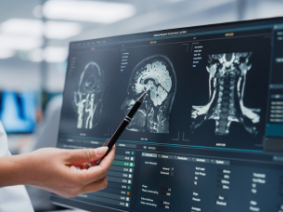Brain Tumor
What Is a Brain Tumor?
Every year, around 90,000 people in the U.S. are diagnosed with a primary brain tumor. That number doesn’t even include the many others who learn that cancer from somewhere else in their body has spread to the brain.
A brain tumor happens when abnormal cells start growing where they shouldn’t—in or around your brain. Some grow slowly and quietly. Others move fast and press on parts of your brain that control how you think, move or feel.
EEG, spinal tap and special imaging techniques that include MRI, computed tomography and positron emission tomography are used to help diagnose a brain tumor. When a tumor is suspected, a biopsy is performed to determine the type of tumor and its stage (how advanced it is).
Types of Brain Tumors
Their effects depend on where they form and how quickly they grow. Some start in your brain, while others spread from cancer in another part of your body.
Primary Brain Tumors
These begin inside your brain or its surrounding tissues. They include the following:
- Gliomas: Include astrocytomas, oligodendrogliomas and glioblastomas (the most aggressive type).
- Meningiomas: Develop in the brain’s outer lining and are usually benign.
- Pituitary adenomas: Grow at the base of the brain and can affect hormones.
- Medulloblastomas: Fast-growing tumors, typically in children.
- Acoustic neuromas: Affect the nerve tied to hearing and balance.
Metastatic Tumors
These come from cancers in other parts of your body, such as the lungs, breasts or skin. They are more common than primary tumors in adults and may appear as one or more growths in the brain.
What Causes Brain Tumors?
There’s still a lot that is not fully understood about what causes brain tumors. However, the following known factors may raise your risk:
- Genetic conditions like Li-Fraumeni syndrome or neurofibromatosis
- Exposure to radiation, especially from earlier cancer treatments
- Family history of brain tumors (rare but possible)
- Spontaneous gene changes that lead cells to grow uncontrollably
- Immune system disorders that may affect how your body monitors cell growth
Brain Tumor Symptoms
Brain tumor symptoms depend on where the tumor is and how quickly it grows. Some people notice subtle changes over time. Others experience sudden, more intense symptoms that point to something serious.
You may experience the following signs of a brain tumor:
- Headaches that feel different from your usual pattern, often worse in the morning
- Seizures without a previous history
- Confusion or difficulty finding the right words
- Nausea, dizziness or vomiting without a clear cause
- Weakness, numbness or balance issues
- Personality shifts, irritability or memory problems
- Blurred or double vision
- Trouble hearing or ringing in your ears
How Brain Tumors Are Diagnosed
At Neurosurgical Associates of Central Jersey, P.A., we use precise tools to understand what’s happening in your brain and why.
Here’s how your physicians may evaluate you:
- MRI or CT scans to locate the tumor and measure its size
- Neurological exams to check your vision, reflexes, balance and thinking
- Biopsy, often using stereotactic guidance, to analyze tumor cells
- Blood tests, especially if hormone-producing tumors are suspected
- Advanced imaging, including functional MRI, to map critical areas before surgery
Treatment Options for Brain Tumors
Surgery
For many brain tumors, surgery is the first and most important step. If the tumor is in a spot that is safe to reach, we aim to remove as much of it as possible. In some cases, taking out part of the tumor can still make a big difference if it helps relieve pressure or makes other treatments work better.
Radiation Therapy
Radiation uses high-energy beams to stop tumor cells from growing. It is often used when surgery is not an option, or if a few tumor cells remain after surgery. Techniques like stereotactic radiosurgery (such as Gamma Knife) allow surgeons to focus treatment on the tumor while sparing the healthy brain tissue around it.
Chemotherapy
Some brain tumors respond to chemotherapy if they have certain genetic traits. You might receive chemo by itself or along with radiation, depending on how your tumor behaves. Our care team will walk you through what to expect and help manage any side effects along the way.
Symptom Relief
Sometimes, the first priority is helping you feel more stable and comfortable. To do that, we may recommend:
- Steroids to ease swelling in the brain
- Anti-seizure medication to lower the risk of seizures
- Shunts to drain excess fluid if pressure builds up
- Rehab therapy to support your thinking, strength or balance after treatment
What Outlook Looks Like
The outlook depends on many moving parts, such as tumor type, size, location, how early it’s caught and how well your body responds to treatment.
- A slow-growing meningioma might be safely monitored or fully removed
- A glioblastoma often requires a more aggressive, multi-step approach
- Tumors with certain genetic changes tend to respond better to treatment
- Younger, healthier patients often have better long-term outcomes
That said, no two cases follow the same path. At Neurosurgical Associates of Central Jersey, your care plan is as individual as your experience.
Talk to a Team That’s With You From Start to Finish
If you’ve been diagnosed with a brain tumor or if you’re experiencing symptoms that raise concern, call Neurosurgical Associates of Central Jersey, P.A. at (732) 302-1720. Our team will take the time to evaluate your symptoms, explain the next steps and stay by your side throughout your care.



